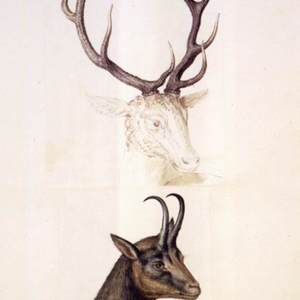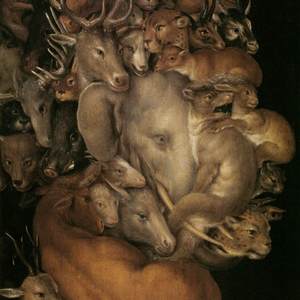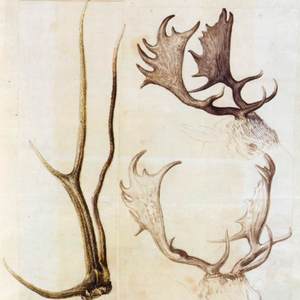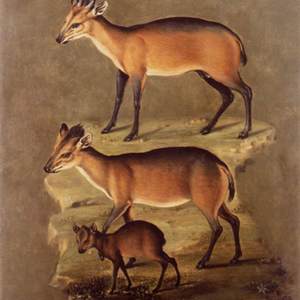Earth

Giuseppe Arcimboldo, "Nature Studies," Watercolour on parchment, Österreichische Nationalbibliothek, Vienna
Arcimboldo composes “Earth” from a variety of animals, and this portrait helps to establish the artist not only as a student of the everyday but also of the exotic. For nestled amongst the deer, mice, wolves, donkeys and sheep one can discover an ibex, an elephant, a lion and a camel, among others. The color palette used for “Earth” does not stray far from browns, reds, and oranges, suggesting the soil and woods without needing either to actually create the face. Arcimboldo utilizes the delicate form and points of the various animals’ antlers to create a coronet, thus crowning his earthly goddess. As a ruler, Maximilian II was fond of animals and kept an exotic menagerie of them at his court, and Arcimboldo could perhaps have done the initial studies for some of the animals pictured here in his patron’s zoo (note 1). These animals are made more exotic by the way Arcimboldo ignores the variations in size the real animals would present and instead chooses to paint them all on relatively equal footing.
However Arcimboldo does choose to include small nods to the realities of the animal world, such as the snarling bear with its open mouth that forms the eye, which twists and snarls in preparation to bite the neck of the rabbit that is perched nearby. Within the various animals, once again done from nature studies though not necessarily studies meant solely for this portrait, are references to the supreme power of the Hapsburg dynasty. The lion skin and sheep fleece hearken to the Greek myth of Hercules and the twelve labors he had to perform as well as the myth of Jason and the Golden Fleece (note 2). Both of the myths cement the portrait’s tie to the ruling family, as the Hapsburgs regarded themselves direct descendants from Hercules while the Golden Fleece provides a reference to the Order of the Golden Fleece (note 3).
The rustic tones of "Earth" are also echoed in its paired painting, "Autumn," as both are done in deep browns with only slight touches of other colors. Both figures have expressions that mirror each other: neither smiling nor frowning, their mouths both form flat expressions without much indication as to their feelings. The tightly packed animals of "Earth" also call to mind hibernation, as the beasts within curl up during the autumn to prepare for the dark days of winter.
Notes
note 1. Pagden, Sylvia Ferino. Arcimboldo: 1526-1593. Milan: Skira, 2007. 151. Print.
note 2. The myth of Hercules is centered around Hercules, one of the sons of Zeus, who murders his wife and children in a fit of rage induced by Hera. To atone for his crime, he must complete twelve labours, one of which involved the slaying of the Namean lion. The myth of Jason and the Golden Fleece tells the story of Jason, the rightful heir to Thessaly, who must embark on a journey to obtain the Golden Fleece in order to take back the throne from his uncle, Pelias.
note 2. Kaufmann, Thomas D. "The Allegories and Their Meaning." The Arcimboldo Effect. New York: Abbeville, 1987. 103. Print.


